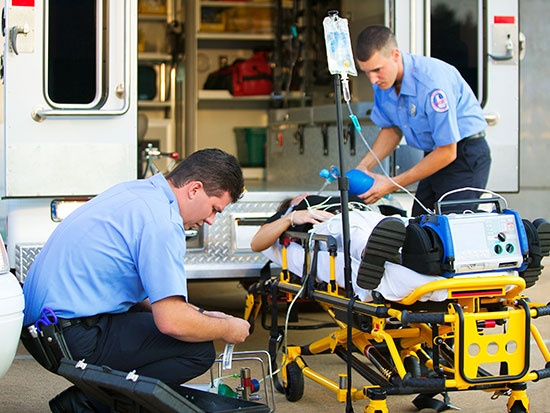 Nearly half a million people are treated for sudden cardiac arrest outside of the hospital each year, according to the American Heart Association, but only about 10 percent survive. That percentage improved significantly when emergency medical services providers used a newer breathing device to manage the airway in the field, according to findings from a multi-center group of researchers, including a team from the University of Alabama at Birmingham.
Nearly half a million people are treated for sudden cardiac arrest outside of the hospital each year, according to the American Heart Association, but only about 10 percent survive. That percentage improved significantly when emergency medical services providers used a newer breathing device to manage the airway in the field, according to findings from a multi-center group of researchers, including a team from the University of Alabama at Birmingham.
The findings were presented this week at the 2018 Society for Academic Emergency Medicine in Indianapolis, Indiana.
“Our research revealed that sudden cardiac arrest patients who received the newer and easier-to-use laryngeal tube as the initial airway had higher survival rates than those individuals who were randomized to an initial strategy of traditional endotracheal intubation. Based on these results, we estimate that EMS providers could save an additional 10,000-plus lives a year,” said Michael Kurz, M.D., co-investigator at UAB and associate professor in the Department of Emergency Medicine in the UAB School of Medicine.
Called the Pragmatic Airway Resuscitation Trial, or PART, the study is the largest of its kind to test oxygen delivery methods used by firefighters, emergency medical technicians and paramedics around the country. Getting oxygen into the lungs is an important part of reviving a patient experiencing sudden cardiac arrest.
| “The newer laryngeal tubes were inserted more quickly and required fewer attempts, leading to better blood flow and oxygen delivery.” |
“EMS providers have traditionally established airways using the same technique that’s used in hospitals, endotracheal intubation,” said Shannon Stephens, the national project director for the PART Trial and researcher in the UAB Department of Emergency Medicine. “But endotracheal intubation in the field can be extremely challenging and prone to errors.”
To conduct the research, Kurz, Stephens and colleagues in Dallas-Fort Worth, Milwaukee, Pittsburgh and Portland compared survival rates among 3,000 adults with sudden cardiac arrest treated by paramedic crews with 27 EMS agencies from December 2015 to November 2016.
Approximately half of study participants were managed initially with the newer laryngeal tube, a device inserted into the esophagus, the opening to the throat and stomach where a person swallows. The device blocks off the esophagus so that air goes only into lungs.
The other half were initially managed with traditional endotracheal intubation, a plastic breathing tube inserted into the trachea, or windpipe, to guide air directly into the lungs. If the initial airway strategy failed, prehospital providers were permitted to use all available rescue strategies including the laryngeal tube and endotracheal tube.
Both breathing tubes are approved by the FDA and are not considered investigational devices. The two devices had not been compared to each other to determine whether one works better than the other until now.
A total of 18.3 percent of participants in the laryngeal tube group survived three days in the hospital, while only 15.4 percent in the intubation group survived three days. A total of 10.8 percent of participating in the laryngeal tube group survived to hospital discharge compared to 8.1 percent in the intubation group. The proportion of participants surviving with good brain function was also higher in the laryngeal tube group.
“The newer laryngeal tubes were inserted more quickly and required fewer attempts, leading to better blood flow and oxygen delivery,” Stephens said. “Additional analysis is ongoing to gain further insight into the study findings.”
PART was conducted by the Resuscitation Outcomes Consortium, a group of investigators and EMS and hospital care providers nationwide who study early treatments for sudden cardiac arrest and severe injuries that cause disabilities and deaths. It was funded by the National Heart, Lung, and Blood Institute, part of the National Institutes of Health.
EMS crews from Birmingham Fire and Rescue and the Bessemer Fire Department participated in the study, along with UAB Hospital, Grandview Medical Center, Brookwood Medical Center, Baptist Medical Center – Princeton, St. Vincent’s Hospital and UAB Medical West Hospital.